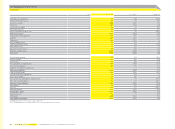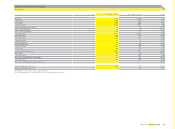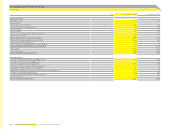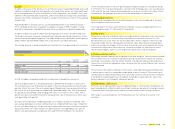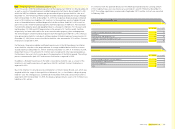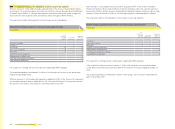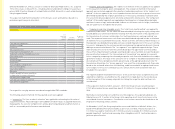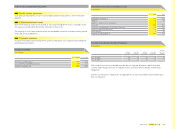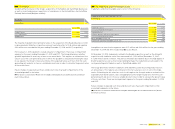Reebok 2008 Annual Report Download - page 165
Download and view the complete annual report
Please find page 165 of the 2008 Reebok annual report below. You can navigate through the pages in the report by either clicking on the pages listed below, or by using the keyword search tool below to find specific information within the annual report.
adidas Group Annual Report 2008 161
Goodwill
Goodwill is the excess of the purchase cost over the fair value of acquired identifi able assets and
liabilities. Goodwill arising from the acquisition of a foreign entity and any fair value adjustments
to the carrying amounts of assets and liabilities of that foreign entity, are treated as assets and
liabilities of the reporting entity respectively, and are translated at exchange rates prevailing at
the date of the initial consolidation. Goodwill is carried in the functional currency of the acquired
foreign entity.
Acquired goodwill is valued at cost less accumulated impairment losses. Effective January 1,
2005, scheduled amortisation of goodwill ceased due to changes in IFRS. Goodwill is tested
annually for impairment, and additionally when there are indications of potential impairment.
Goodwill has been allocated for impairment testing purposes to three cash-generating units.
The Group’s cash-generating units are identifi ed according to major brand of operations in line
with the internal management approach. The adidas Group has thus defi ned the three segments
adidas, Reebok and TaylorMade- adidas Golf as the relevant cash-generating units.
The carrying amounts of acquired goodwill are allocated to the cash-generating units as follows:
Allocation of goodwill
€ in millions
adidas Reebok
TaylorMade-
adidas Golf
Total
goodwill
January 1, 2008 748 406 282 1,436
Additions 18 — — 18
Currency effects 24 19 2 45
December 31, 2008 790 425 284 1,499
In 2008, the adidas Group determined that no impairment of goodwill was necessary.
The recoverable amount of a cash-generating unit is determined on the basis of value in use.
This calculation uses cash fl ow projections based on the fi nancial planning covering a fi ve-year
period in total in the case of the cash-generating unit Reebok and a four-year period in total in
the case of the cash-generating units adidas and TaylorMade-adidas Golf. Cash fl ows beyond
this period are extrapolated using steady growth rates of 1.7% (2007: 2.0% to 2.5%). These
growth rates do not exceed the long-term average growth rate of the business in which each
cash- generating unit operates.
Discount rates are based on a weighted average cost of capital calculation considering a fi ve-
year average debt /equity structure and fi nancing costs including the Group’s major competitors
of each cash-generating unit. The discount rates used are after-tax rates and refl ect the specifi c
equity and country risk of the relevant cash-generating unit. The applied discount rates for
specifi c cash-generating units are between 8.2% and 8.8% (2007: between 7.5% and 8.4%).
The recoverable amount of the cash-generating unit Reebok exceeds its carrying amount by
€ 108 million. This cash-generating unit is sensitive to the following areas: a net sales decrease
of 5% over the fi ve-year fi nancial planning period or an increase of the discount rate by 0.3 per-
centage points (by applying a discount rate of 8.4%) would lead to an impairment.
Research and development
Research costs are expensed as incurred. Development costs are also expensed as incurred
when recognition criteria are not met.
The Group spent € 81 million and € 84 million on product research and development for the
years ending December 31, 2008 and 2007, respectively.
Financial assets
All purchases and sales of fi nancial assets are recognised on the trade date. Costs of purchases
include transaction costs. If the fair value of available-for-sale fi nancial assets (i.e. non-
derivative fi nancial assets which are not allocable under another category of IAS 39) can be
measured reliably, they are subsequently carried at fair value. Realised and unrealised gains
and losses arising from changes in the fair value of fi nancial assets are included in the income
statement for the period in which they arise, except for available-for-sale fi nancial assets
where unrealised gains and losses are recognised in equity unless they are impaired.
Borrowings and other liabilities
Borrowings and other liabilities are recognised at fair value using the “effective interest method”,
net of transaction costs incurred. In subsequent periods, long-term borrowings are stated at
amortised cost using the “effective interest method”. Any difference between proceeds (net of
transaction costs) and the redemption value is recognised in the income statement over the term
of the borrowing.
The fair value of the liability component of the Group’s convertible bond was determined using
a market interest rate for a comparable straight bond at time of issuance. This amount is pre-
sented as part of long-term borrowings on an amortised cost basis until conversion or maturity
of the bond. The remaining portion is included in shareholders’ equity where the value of the
equity component is not changed in subsequent periods.
Accrued liabilities and provisions
Provisions are recognised where a present obligation (legal or constructive) to third parties has
been incurred which is likely to lead to an outfl ow of resources, and where the timing or amount
is uncertain. Non-current provisions are discounted if the effect of discounting is material.
With respect to accrued liabilities, the timing and amount of an outfl ow of resources is not
uncertain.



